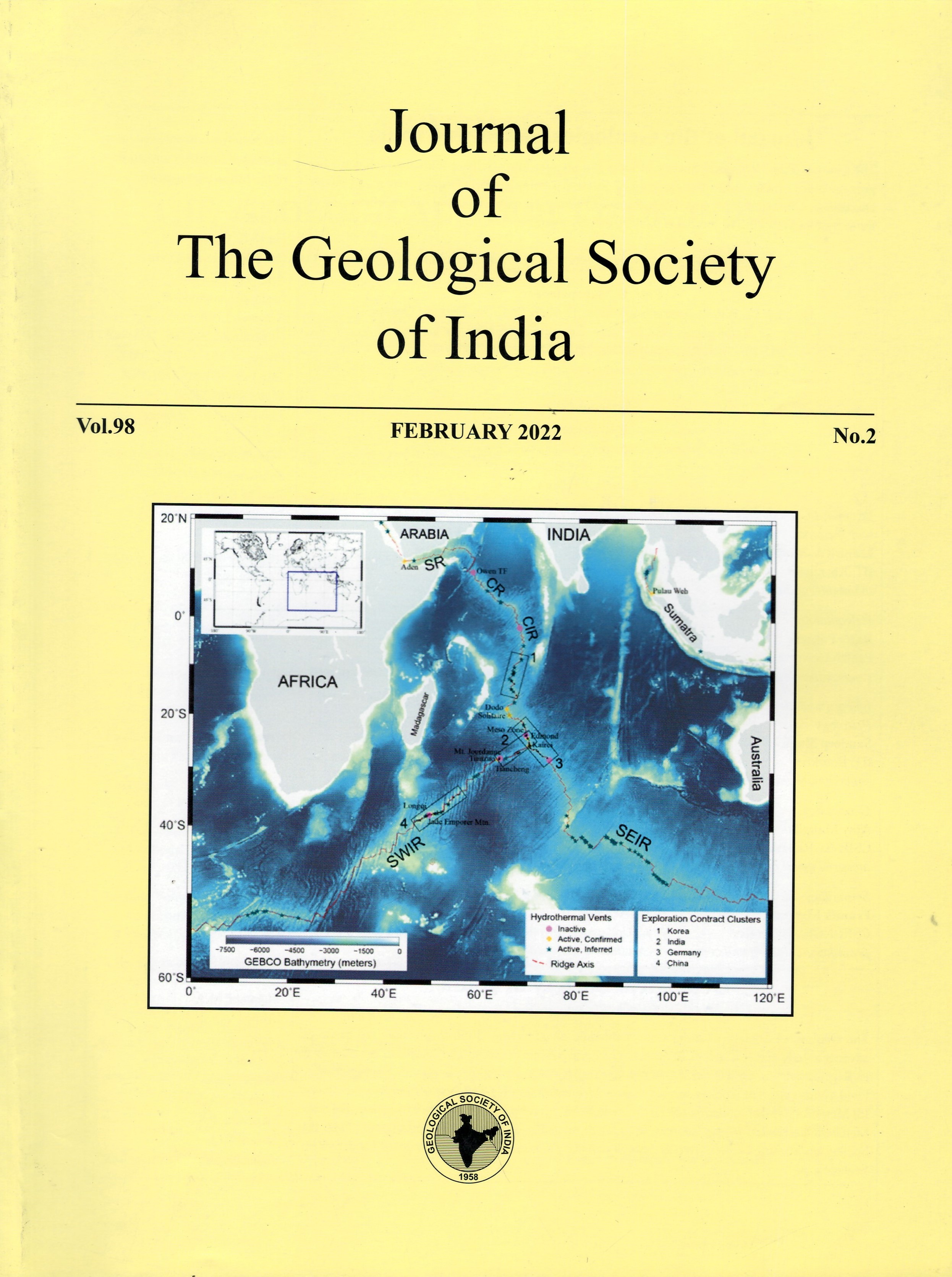Geochemistry and Utilization of Water from Thermal Springs of Tawang and West Kameng Districts, Arunachal Pradesh
DOI:
https://doi.org/10.1007/s12594-022-1964-7Keywords:
No KeywordsAbstract
The hydrogeochemical studies provide insights about reservoir conditions of geothermal springs along with utilization of thermal waters for domestic, livestock and irrigation purposes. Most of the hot springs of Tawang and West Kameng districts of Arunachal Pradesh emanated through garnet bearing high grade gneiss-migmatite-schist-quartzite sequence of the Se La Group, except for Dirang hot springs which emanate from river terrace deposits lying on the footwall of deformed quartzite-phyllite. The thermal waters are of mixed Na-Ca-HCO3-SO4-Cl type, meteoric in origin and at the same time immature in nature, moving sluggishly towards mineral-fluid equilibration zone with slow rock-water interactions. Chemical geothermometry showed wide variation in estimation of sub-surface reservoir temperature and quartz geo-thermometry model fits prominently to provide the most reliable reservoir temperature varying within 90±40°C. The studies recorded highest reservoir temperature of Thingbu hot spring with 133°C with very high fluoride concentration in all the hot springs except Bishum and Phudung as per BIS (2012) IS: 10500 specifications. High fluoride and sulfate concentration in thermal spring waters make it unsuitable for drinking purpose. The applicability of thermal waters for irrigation is predicted through sodium adsorption ratio (SAR) calculations which showed that waters of Dirang-2, Sorbe and Kitpi-1&2 are not suitable for irrigation purpose due to high salinity and SAR values.
Downloads
Metrics
Issue
Section
Published
How to Cite
References
APHA (2006) Standard methods for the examination of water and waste; American Public Health Association, Washington DC.
Apollaro, C., Vespasiano, G., Muto, F., De Rosa, R., Barca, D., and Marini, L. (2016) Use of mean residence time of water, flow rate, and equilibrium temperature indicated by water geothermometers to rank geothermal resources. Application to the thermal water circuits of Northern Calabria. Jour. Volcanol. Geotherm. Res., v.328, pp.147-158.
Appelo, C.A.J. and Postma, D. (2004) Geochemistry, Groundwater and Pollution. CRC press.
Singh, H.K., Chandrasekharam, D., Trupti, G., Mohite, P., Singh, B., Varun, C. and Sinha, S.K. (2016) Potential geothermal energy resources of India: a review. Curr. Sustain. Energy Rep.,.3(3-4), pp.80–91.
Ármannsson, H., Fridriksson, T., and Kristjánsson, B.R. (2005) CO2 emissions from geothermal power plants and natural geothermal activity in Iceland. Geothermics, v.34, pp.286-296.
Bakliwal, P.C., and Das, A.K. (1971) Geology of parts of Kameng district, NEFA. Geol. Surv. India Unpub. Prog. Report, FS: 1970-71.
Bhattacharjee, S. and Nandy, S. (2007) Geology of the western Arunachal Himalaya in parts of Tawang and West Kameng districts, Arunachal Pradesh. Jour. Geol. Soc India, v.72, pp.192-207.
Bhattacharjee, S. and Nandy, S. (2017) Petrology and geochemistry of the Himalayan granites from Western Arunachal Pradesh, India. Indian Jour. Geosci., v.71(2), pp.439-448.
Bora, L., Kar A., Baruah, I. and Kalita, M.C. (2006) Hot springs of Tawang and West Kameng districts of Arunachal Pradesh. Curr. Sci., v.91(8), pp.1011-1013.
Bureau of Indian Standards (2012) Indian standard specifications for drinking water. 10500: BIS: New Delhi, India.
Dávalos-Elizondo, E., Atekwana, E.A., Atekwana, E.A., Tsokonombwe, G. and Laó-Dávila, D.A. (2021) Medium to low enthalpy geothermal reservoirs estimated from geothermometry and mixing models of hot springs along the Malawi Rift Zone. Geothermics, v.89 pp.101963.
Fournier, R.O. (1979b) Geochemical and hydrologic considerations and the use of enthalpy-chloride diagrams in the prediction of underground conditions in hot-spring systems. Jour. Volcanol. Geotherm. Res., v.5, pp.1-16.
Giggenbach, W.F. (1986) Graphical techniques for the evaluation of water/rock equilibration conditions by use of Na, K, Mg, and Ca contents of discharge waters. Proc. 8th NZ Geothermal Workshop, Auckland.
Hem, J.D. (1985) USGS Water Supply Paper 2254, pp.117-120. Kaura S.C. and Basu Roy S. (1982) Geology of the Kameng district, Arunachal Pradesh. Unpub. Rep. GSI, Field Season: 1979-81
Kesari, G.K. (2010) Geology and Mineral Resources of Arunachal Pradesh. Geol. Surv. India, Misc. Publ., v.30(IV), I(i).
Joshi, D.M., Kumar, A. and Agrawal, N. (2009) Assessment of the irrigation water quality of river Ganga in Haridwar district. Rasayan. Jour. Chem., v.2, pp.285-292.
Piper, A.M. (1944) A graphical procedure in the geochemical interpretation of water analysis. Trans. Am. Geophys. Union, v.25(6), pp.914-928.
Richards, L.A. (1954) Diagnosis Improvement Saline Alkali Soils. US Department of Agriculture Handbook, 60p.
Singh, H.K., Sinha, S.K., Alam, M.A. and Chandrasekharam, D. (2020) Tracing the evolution of thermal springs in the Hazaribagh area of Eastern Peninsular India through hydrogeochemical and isotopic analyses. Geothermics, v.85, pp.101817.
Taye, C. D. andChutia, A. (2016) Physical and chemical characteristics of a few hot springs of Tawang and West Kameng District, Arunachal Pradesh, North-East India. Jour. Assam Sci. Soc., v.57, pp.47-55.
Todd, D. K. (1980) Groundwater hydrology [M], 2nd edn. Wiley, New York. pp.535.

 Archisman Dutta
Archisman Dutta






